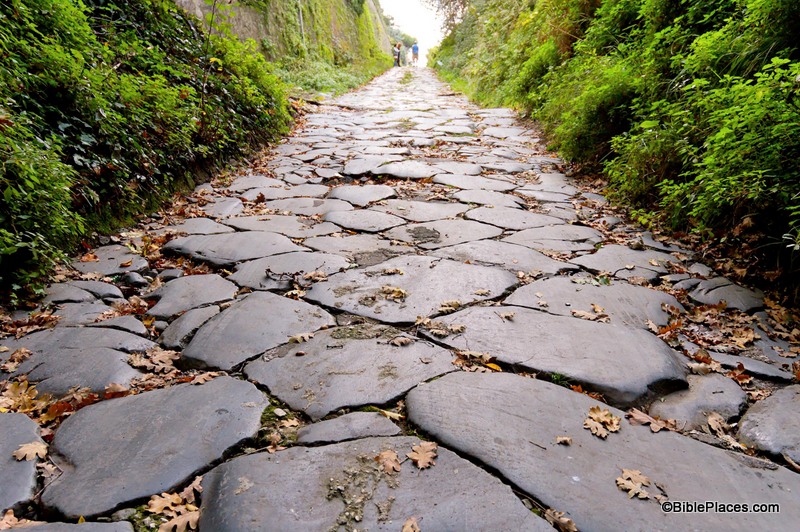(Post by Seth M. Rodriquez)
When people think of “biblical archaeology” they usually think of cities such as Jerusalem, Jericho, or Capernaum. However, sometimes a road can be just as valuable as an archaeological “site.”
Our picture of the week is from Volume 15 of the revised and expanded version of the Pictorial Library of Bible Lands, which focuses on Rome. The photo is entitled, “Appian Way with Ancient Paving Stones.”
Although never explicitly mentioned in Acts 28, there can be little doubt that the Apostle Paul walked this road as he traveled from Puteoli (Acts 28:13) to Rome (Acts 28:14). From Puteoli, Paul and his escort of Roman soldiers probably travelled north to Capuae (also spelled Capua) where they travelled the rest of the journey to Rome on the Appian Way. In his 1962 work on Archaeology and the New Testament, Merrill F. Unger describes the journey in this way:
Not far from Puteoli at Capua, Paul and the group got on the Appian Way which connected with Rome via The Forum of Appius and The Three Taverns. Extensive sections of this well-paved road, planned by the censor Appius Claudius Caecus in 312 B.C., still exist, lined with tombs, sites of ancient Roman villas, and ruins of ancient aqueducts. … From Capua it was 132 miles to Rome. …
Since the Appian Way from Capua to Terracina Romeward skirted near the shore, picturesque vistas of land often combined with a magnificent view of the sea. …
At the Forum of Appius, 43 miles from the metropolis on the Tiber, Paul and the group had a pleasant surprise. Some of the believers at Rome, Luke writes, “came to meet us” (Acts 28:15), employing a word (apantēsis) technically used for the official welcome of a visiting dignitary by a deputation which went out of a city to greet him and conduct him on his way for the last part of his journey. …
Now on both sides of the Appian Way were seen the tombs and funerary memorials of the generals, conquerors, and distinguished men who had raised an obscure Italian town to the position of the first city of the world, and surrounded it with a halo of martial glory unexcelled by any other metropolis. Many of these illustrious Romans had passed over this same road to enjoy a magnificent triumph in the city. But the prisoner who that day was surrounded by a retinue of converts and a few Roman soldiers was being led in a triumph far more memorable than that of any victorious Roman general.
Excerpt is taken from Merrill F. Unger, Archaeology and the New Testament (Grand Rapids: Zondervan, 1962), 314-316, and can be purchased here. This and other photos of Rome are included in Volume 15 of the Pictorial Library of Bible Lands and can be purchased here.

One thought on “Picture of the Week: Appian Way with Ancient Paving Stones”
Fascinating!